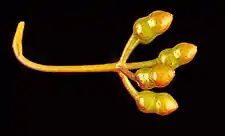| Cherry-fruited mallee | |
|---|---|
 | |
| Scientific classification | |
| Kingdom: | Plantae |
| Clade: | Tracheophytes |
| Clade: | Angiosperms |
| Clade: | Eudicots |
| Clade: | Rosids |
| Order: | Myrtales |
| Family: | Myrtaceae |
| Genus: | Eucalyptus |
| Species: | E. cerasiformis |
| Binomial name | |
| Eucalyptus cerasiformis | |
Eucalyptus cerasiformis, commonly known as the cherry-fruited mallee,[2] is a mallee that is endemic to a small area of Western Australia. It has smooth, pale grey, sometimes powdery bark, lance-shaped adult leaves, flower buds in groups of seven, pale yellow or whitish flowers and cylindrical or bell-shaped fruit.


Description
Eucalyptus cerasiformis is a mallee that typically grows to a height of 2 to 3.5 metres (7 to 11 ft) and has smooth, pale grey and white, sometimes powdery bark. The adult leaves are thin and the same glossy, grey-green on both sides. The leaf blade is narrow lance-shaped, 50–112 mm (2.0–4.4 in) long and 5–14 mm (0.20–0.55 in) wide on a petiole 8–20 mm (0.31–0.79 in) long. The flower buds are borne in groups of seven in leaf axils on a thin peduncle 18–50 mm (0.71–1.97 in) long, the individual buds on a pedicel 7–16 mm (0.28–0.63 in) long. Mature buds are more or less cylindrical, 9–11 mm (0.35–0.43 in) long and 5–6 mm (0.20–0.24 in) wide with a conical to rounded operculum with a point on the tip. Flowering occurs between December and March and the flowers are pale yellow or whitish. The fruit is a woody cylindrical, bell-shaped, urn-shaped or hemispherical capsule.[2][3][4][5]
Taxonomy and naming
Eucalyptus cerasiformis was first formally described in 1978 by Ian Brooker and Donald Blaxell from a specimen collected by Blaxell near the Hyden - Norseman Road, 164 km (102 mi) east of Hyden. The description was published in the journal Nuytsia.[5][6] The specific epithet (cerasiformis) is derived from the Latin cerasus meaning "cherry-tree"[7]: 194 and -formis meaning "shape",[7]: 46 referring to the hanging flower buds resembling a bunch of cherries.[2]
Distribution and habitat
Cherry-fruited mallee is only known from the type location, just north of Lake Johnston where it grows in low, open forest in red-loamy soils.[2][3][4]
Conservation status
This eucalypt is classified as "Priority Four" by the Government of Western Australia Department of Parks and Wildlife,[3] meaning that is rare or near threatened.[8]
See also
References
- ↑ "Eucalyptus cerasiformis". Australian Plant Census. Retrieved 22 April 2019.
- 1 2 3 4 "Eucalyptus cerasiformis". Euclid: Centre for Australian National Biodiversity Research. Retrieved 4 June 2020.
- 1 2 3 "Eucalyptus cerasiformis". FloraBase. Western Australian Government Department of Biodiversity, Conservation and Attractions.
- 1 2 Chippendale, George M. "Eucalyptus cerasiformis". Australian Biological Resources Study, Department of the Environment and Energy, Canberra. Retrieved 23 April 2019.
- 1 2 Brooker, Donald F. Ian; Blaxell, W. (1978). "Five new species of Eucalyptus from Western Australia". Nuytsia. 2 (4): 226–228. Retrieved 23 April 2019.
- ↑ "Eucalyptus cerasiformis". APNI. Retrieved 22 April 2019.
- 1 2 Brown, Roland Wilbur (1956). The Composition of Scientific Words. Washington, D.C.: Smithsonian Institution Press.
- ↑ "Conservation codes for Western Australian Flora and Fauna" (PDF). Government of Western Australia Department of Parks and Wildlife. Retrieved 22 April 2019.
